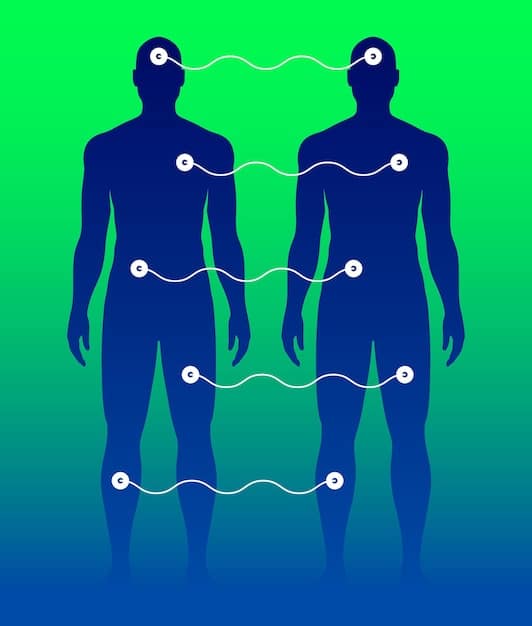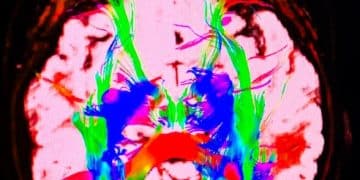Comparing Anxiety Therapies: Effectiveness Analysis

Comparing the effectiveness of different types of therapy for anxiety reveals that cognitive behavioral therapy (CBT) often serves as a foundational treatment, while other modalities like psychodynamic therapy and mindfulness-based approaches offer valuable complementary or alternative pathways for sustained relief and improved mental well-being.
Navigating the complex landscape of mental health can be daunting, especially when seeking relief from anxiety. Understanding the nuances involved in comparing the effectiveness of different types of therapy for anxiety is crucial for making informed decisions on your path to wellness. This article aims to demystify these options, providing a clear and comprehensive overview to help you and your loved ones identify the most suitable therapeutic approaches.
Cognitive Behavioral Therapy (CBT): The Evidence-Based Cornerstone
Cognitive Behavioral Therapy (CBT) has long been recognized as a gold standard in treating anxiety disorders. Its effectiveness is rooted in its highly structured, goal-oriented approach, focusing on the intricate connection between thoughts, feelings, and behaviors. CBT operates on the premise that distorted thinking patterns and problematic behaviors contribute significantly to anxiety symptoms, and by identifying and modifying these, individuals can achieve substantial relief.
The core methodology of CBT involves a systematic process. Therapists work with clients to spotlight negative thought patterns, such as catastrophic thinking or overgeneralization, which often fuel anxiety. Once identified, these thoughts are challenged and reframed into more realistic and positive perspectives. Concurrently, behavioral techniques are integrated:
Key CBT Components
- Exposure Therapy: Gradually exposing individuals to anxiety-provoking situations in a controlled environment to reduce avoidance behaviors and desensitize fear responses.
- Cognitive Restructuring: Learning to recognize, challenge, and change unhelpful thought patterns that contribute to anxiety.
- Relaxation Techniques: Incorporating breath work, progressive muscle relaxation, and other methods to manage physical symptoms of anxiety.
- Behavioral Experiments: Testing out negative predictions to see if they hold true, often disproving fears and building confidence.
Research consistently supports CBT’s efficacy across a spectrum of anxiety disorders, including Generalized Anxiety Disorder (GAD), Panic Disorder, Social Anxiety Disorder, and specific phobias. Its short-term, solution-focused nature makes it an attractive option for many seeking rapid symptom reduction. However, while highly effective for symptom management, some critics suggest that CBT may not always delve into the deeper, historical roots of anxiety, leaving some individuals seeking more profound insights into their emotional landscape.
Psychodynamic Therapy: Unearthing Deeper Roots
In contrast to CBT’s focus on present-day thoughts and behaviors, psychodynamic therapy delves into the unconscious mind, seeking to understand how past experiences and unresolved conflicts influence current anxiety. This therapeutic approach, originating from Freudian psychoanalysis, posits that anxiety often stems from underlying emotional issues, repressed feelings, or early life experiences that continue to impact an individual’s emotional responses and relationships.
Psychodynamic therapy is typically longer-term and less structured than CBT. The therapeutic process encourages free association, dream analysis, and exploration of relational patterns to uncover these hidden dynamics. The therapist acts as a guide, helping the client recognize how these unconscious forces manifest as anxiety symptoms in their daily lives. By bringing these hidden conflicts to conscious awareness, individuals can gain insight and work towards resolving them, leading to a more profound and lasting sense of emotional well-being.
Therapeutic Mechanisms
- Exploration of Past Experiences: Examining childhood traumas, family dynamics, and significant life events to understand their current impact.
- Insight Development: Helping clients connect their current emotional distress to underlying, often unconscious, psychological processes.
- Transference Analysis: Understanding how past relationship patterns are re-enacted in the therapeutic relationship, providing a safe space for resolution.
While often requiring a greater time commitment, psychodynamic therapy can offer a deeper, more holistic understanding of anxiety, potentially leading to more fundamental personality changes and improved relational functioning. It might not provide immediate symptom relief as quickly as CBT, but for individuals seeking to understand the origins of their anxiety and achieve more comprehensive personal growth, it can be a highly rewarding path. The effectiveness can vary more significantly depending on the therapist’s skill and the client’s commitment to self-exploration.

Mindfulness-Based Therapies: Embracing the Present Moment
Mindfulness-based therapies represent a significant shift in the approach to anxiety, focusing less on changing thoughts or exploring the past and more on cultivating a present-moment awareness and acceptance. Drawing from ancient contemplative traditions, these therapies teach individuals to observe their thoughts, feelings, and bodily sensations without judgment, thereby reducing the intensity of anxious reactions. The philosophy behind mindfulness is that much suffering arises from resisting or reacting to difficult internal experiences.
Programs like Mindfulness-Based Stress Reduction (MBSR) and Mindfulness-Based Cognitive Therapy (MBCT) are prominent examples. MBSR, initially developed for chronic pain, has shown remarkable effectiveness in reducing anxiety by teaching participants formal mindfulness meditation practices, such as body scans, sitting meditation, and mindful movement (e.g., gentle yoga). MBCT specifically integrates elements of CBT with mindfulness practices, particularly for preventing relapse in depression, but its principles are highly applicable to anxiety.
The core practices involve:
Mindfulness Techniques
- Focused Attention: Directing attention to a specific object, like the breath, to quiet the mind.
- Open Monitoring: Observing all present-moment phenomena (thoughts, sounds, sensations) without attachment or judgment.
- Body Scan Meditation: Systematically bringing awareness to different parts of the body to notice sensations.
By learning to non-judgmentally observe anxious thoughts and feelings as transient mental events rather than absolute truths, individuals can disengage from the automatic spirals of worry. This creates a space for a more balanced and compassionate response to internal distress. While not a quick fix, mindfulness-based therapies offer a robust set of skills for long-term anxiety management, fostering resilience and a greater sense of inner peace. Their effectiveness is increasingly supported by neuroscience research, highlighting changes in brain regions associated with emotion regulation.
Acceptance and Commitment Therapy (ACT): Valuing Action
Acceptance and Commitment Therapy (ACT) is a contemporary behavioral therapy that stands apart from traditional CBT in some key ways, while sharing its evidence-based foundation. Instead of challenging or changing maladaptive thoughts, ACT encourages individuals to accept unwanted thoughts and feelings as normal aspects of human experience. The central tenet is not to eradicate anxiety, but to reduce its impact by changing how one relates to it.
ACT employs a blend of acceptance and mindfulness strategies alongside commitment and behavior change techniques. The “acceptance” component involves willingly making room for uncomfortable sensations, thoughts, and emotions, rather than fighting against them. The “commitment” aspect emphasizes identifying deeply held personal values and taking committed action towards living a life congruent with those values, even in the presence of anxiety. This redirection of energy from internal struggle to value-driven action is powerful.
Core Processes of ACT
- Mindfulness: Developing the ability to be present and aware of thoughts and feelings without getting entangled in them.
- Cognitive Defusion: Learning to observe thoughts as just thoughts, rather than literal truths or commands.
- Acceptance: Opening up to and allowing difficult private experiences to be present without resistance.
- Values: Clarifying what truly matters most in life (e.g., connection, growth, compassion).
- Committed Action: Taking purposeful steps, guided by values, even when fear or discomfort arises.
ACT has shown promise in treating various anxiety disorders by fostering psychological flexibility, which is the ability to adapt to changing situational demands, shift perspectives, and persist in actions that align with one’s values. It offers a unique approach for those who find the continuous struggle against anxious thoughts exhausting, providing a framework for living a rich and meaningful life alongside anxiety, rather than striving for its complete absence.
Interpersonal Therapy (IPT): Understanding Relational Impact

Interpersonal Therapy (IPT) offers a distinct perspective on anxiety, positing that psychological distress, including anxiety, often arises from difficulties in a person’s relationships and social roles. Unlike therapies that focus on internal thoughts or past traumas, IPT primarily examines the interplay between an individual’s symptoms and their current interpersonal environment. The assumption is that improving communication skills, addressing relational conflicts, and navigating social transitions can significantly alleviate anxiety symptoms.
IPT is typically short-term, structured, and focuses on one or two specific interpersonal problem areas. These areas commonly include grief, role disputes (conflicts with significant others), role transitions (adjusting to major life changes like marriage, divorce, or new parenthood), and interpersonal deficits (difficulty forming or maintaining relationships). The therapist helps the client identify how these interpersonal issues contribute to their anxiety and then develops strategies to improve relational functioning.
Focus Areas of IPT
- Grief: Processing the loss of a loved one and adjusting to life without them.
- Role Disputes: Resolving conflicts or disagreements with important people in one’s life.
- Role Transitions: Adapting to changes in life circumstances that impact one’s social roles.
- Interpersonal Deficits: Addressing persistent difficulties in social interactions and relationship building.
While originally developed for depression, IPT has demonstrated effectiveness in treating various anxiety disorders, particularly those with a strong social or relational component, such as social anxiety disorder. By empowering individuals to navigate their social world more effectively and build stronger, healthier relationships, IPT can lead to a reduction in anxiety and an overall improvement in quality of life. It’s particularly beneficial for those whose anxiety is markedly triggered or maintained by interpersonal stressors.
Choosing the Right Path: Factors to Consider
With a diverse array of therapeutic approaches available, deciding which type of therapy is most effective for an individual’s anxiety requires careful consideration. There is no one-size-fits-all solution, as the efficacy of therapy is profoundly influenced by numerous factors unique to each person. A combination of personal preference, the specific nature of the anxiety disorder, life circumstances, and the therapeutic relationship itself all play pivotal roles in determining success.
Firstly, the severity and specific type of anxiety disorder are crucial. For instance, specific phobias often respond exceptionally well to exposure-based CBT techniques, while generalized anxiety disorder might benefit from a broader approach incorporating elements of mindfulness or psychodynamic exploration. Panic disorder often sees significant relief with CBT strategies targeting panic attacks and avoidance behaviors. Social anxiety frequently improves with both CBT and interpersonal therapy, as they address both cognitive distortions and social interaction skills.
Secondly, personal preference and readiness for change are paramount. Some individuals prefer the structured, goal-oriented nature of CBT, finding its practical tools and clear objectives empowering. Others may prefer the deeper, more exploratory journey offered by psychodynamic therapy, seeking to understand the historical roots of their distress. Mindfulness-based approaches appeal to those interested in cultivating present-moment awareness and acceptance, while ACT resonates with individuals looking to align their actions with their values despite anxiety. A therapy’s theoretical approach must align with a client’s worldview and comfort level for optimal engagement.
Thirdly, the therapeutic alliance – the quality of the relationship between the client and therapist – is widely recognized as a central predictor of treatment success across all modalities. Feeling understood, respected, and safe with a therapist can significantly enhance treatment outcomes, regardless of the specific techniques employed. Regardless of the chosen therapy, a strong, trust-based relationship forms the bedrock upon which healing can occur.
Finally, practical considerations such as treatment duration, cost, and accessibility should also factor into the decision. Some therapies are designed to be short-term, while others are open-ended. Financial resources and therapist availability in one’s geographical area can also influence choices. Consulting with a mental health professional who can provide a comprehensive assessment and guide the decision-making process is often the most effective first step toward identifying the therapeutic path best suited for one’s unique needs and circumstances.
| Key Therapy | Brief Description & Focus |
|---|---|
| 🧠 CBT | Focuses on changing distorted thoughts and behaviors. Highly structured, evidence-based for symptom reduction. |
| 🛋️ Psychodynamic | Explores unconscious conflicts and past experiences; aims for deeper insight and lasting change. |
| 🧘 Mindfulness-Based | Cultivates present-moment awareness and acceptance of thoughts without judgment; reduces reactive patterns. |
| 🤝 ACT | Fosters psychological flexibility; accepts difficult feelings while committing to value-driven actions. |
Frequently Asked Questions About Anxiety Therapy
The timeline for results varies significantly. With structured therapies like CBT, some individuals may experience noticeable symptom reduction within 8-12 sessions. However, more profound and lasting change often requires longer engagement. Psychodynamic and other insight-oriented therapies may take more time to yield results, as they delve into deeper underlying issues.
Yes, combining psychotherapy with medication is a common and often highly effective approach for managing anxiety disorders. Many studies suggest that a combination of the two can be more beneficial than either treatment alone, especially for moderate to severe anxiety. Always consult with a qualified medical professional to discuss medication options.
It’s common for individuals to try a few different therapeutic approaches before finding the best fit. If a particular therapy isn’t yielding the desired results, it doesn’t mean therapy isn’t for you. It’s an opportunity to discuss with your therapist, consider a different modality, or find a different therapist whose style better resonates with your needs and personality.
For many individuals, online therapy, or telehealth, has proven to be as effective as in-person sessions for anxiety disorders, especially for those with mild to moderate symptoms. It offers convenience and accessibility, which can reduce barriers to treatment. However, severe cases or specific needs might still benefit more from traditional face-to-face sessions.
The therapeutic alliance, or the relationship between client and therapist, is consistently cited as one of the most critical factors predicting successful outcomes in therapy, irrespective of the specific modality used. Feeling understood, trusted, and comfortable with your therapist fosters an environment conducive to healing and personal growth.
A Personalized Path to Well-being
In conclusion, the journey to managing and overcoming anxiety is deeply personal and multifaceted. While Cognitive Behavioral Therapy stands out for its strong evidence base and practical effectiveness in symptom reduction, the landscape of therapy offers a rich array of alternatives—from the insightful depths of psychodynamic work to the present-moment awareness of mindfulness and the value-driven actions of ACT, alongside the relational focus of IPT. Understanding the unique strengths and focuses of each approach is the first step in making an informed decision. Ultimately, the most effective therapy for anxiety is one that resonates with your personal circumstances, aligns with your treatment goals, and is delivered by a compassionate and competent professional with whom you can build a strong therapeutic alliance, paving the way for lasting relief and improved mental well-being.





